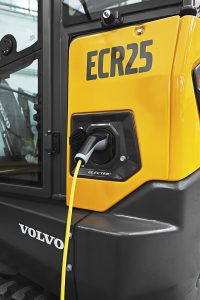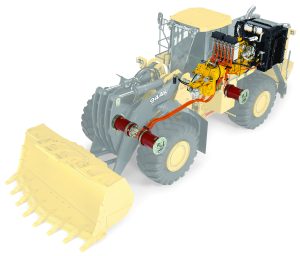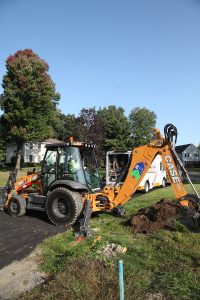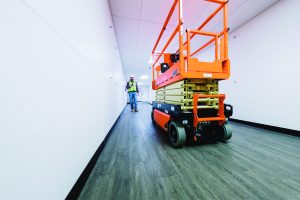
Electric machines are on the job
By Adam Freill
Construction Equipment Equipment TechnologyZero emissions and noise provide entry point for growing segment of the equipment market.
With consumer interest in electric vehicles and decarbonization at an all-time high, it should come as no surprise that electricity is making in-roads into the heavy construction sector as well.
What some might find surprising, however, is that electric- powered machinery is not a new development in the world of construction. There have been electric and hybrid machines available for a number of years.
For example, access equipment manufacturer JLG has been offering electrified lifts for more than two decades, and John Deere introduced its first electrified construction machines in 2012.
What is new, however, is the volume of manufacturers who have entered, and continue to enter, this growing segment of the machinery market, as well as the breadth of machines that have been released recently, or that are in varying stages of development.
“Today’s demand for more eco-friendly products is accelerating the adoption of electric products into more and more construction applications, driving the need for larger, heavier electrified equipment,” says Jennifer Stiansen, director of marketing at JLG.
“While it’s still a relatively small portion of the construction equipment industry, it is growing,” adds Grant Van Tine, solutions marketing manager at John Deere.
“There’s no doubt that electric equipment will become an integral part of the industry in general,” predicts Henry Lawson, director of sales for Takeuchi-US. Takeuchi recently introduced a battery-powered compact excavator to North America.
FIRST UP: COMPACT EQUIPMENT
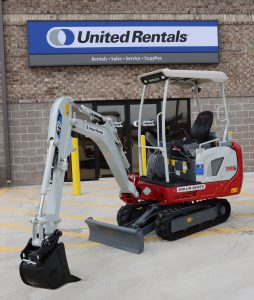
Takeuchi’s new TB20e electric compact excavator will soon be available at select United Rentals locations in North America. (Photo: Takeuchi-US)
While engineering research and development departments are working to bring battery power to all types and sizes of machinery, the starting point for many manufacturers has been the development of electric machines for the compact equipment category.
“Compact machines are where electrification will establish itself first because these machines are versatile and in high demand, and current low-voltage battery options work best on smaller machines,” explains Ray Gallant, vice-president, product management and productivity at Volvo Construction Equipment.
“You need less battery size to get an adequate working time before a recharge,” says Aaron Kleingartner, product and dealer marketing manager at Doosan Infracore North America. “I think that factors in.”
“The practical executions of electric equipment revolve around proximity to a suitable power source, and being able to establish a machine run time that makes it suitable for operating for a whole day, or most of a day, on site,” adds Brad Stemper, North American construction equipment product manager at CASE. “That’s why you’re seeing many of the initial waves of electrified construction equipment revolving around lighter equipment.”
Having access to local power for a quick re-charge over the lunch hour and at other idle times will help some present-generation machines put in a full day of work, as will being able to shut down the motor to conserve power between tasks. That is a big difference from traditional diesel-powered machines that generally have to idle, burning fuel.
States Gallant, “Electric motors have full torque available at any rpm for fast response, and they can shut off when not working and start instantly when needed.”
That’s a power-saver that explains the wide variance in estimated run times for some equipment, as the task will heavily influence battery performance.
THE BENEFITS OF GOING ELECTRIC
The most apparent, and primary, appeal of battery-powered machinery is the reduction or elimination of machine emissions, but that’s not the only factor driving growth in this segment.
“Corporate sustainability goals, project specific emissions requirements, indoor or poor ventilation operation conditions, and the desire for low jobsite noise are some of the common reasons,” says Van Tine.
“Cleaner, quieter solutions are a big plus for indoor and environmentally sensitive work,” adds Stiansen, who explains that the new technologies have made it possible to expand into additional applications, such as operation of lifts in clean room facilities.
“Electric machine owners might be able to expand their offerings. Indoor jobs, food production facilities, high-dust environments and other applications where combustion engines and diesel fumes are a problem may now be open to them with electric machines,” concurs Gallant.
With fewer fluids and filters on a battery-powered machine, engine-related maintenance is also simplified, which can make the lifetime cost of ownership appealing, he adds. “Essentially, the only supplies required for a technician working on Volvo electric excavators are grease and hydraulic oil.”
Meeting environmental goals without sacrificing performance or power is also a plus for reduced or zero-emission machinery but, he continues, “it’s about more than environmental sustainability. Fully electric machines are also much quieter than diesel equipment.”
For contracting firms operating in tight quarters, in areas with noise regulations, or in close proximity to populated areas, the low noise and vibration levels of electric machines can help keep peace in the neighbourhood, in more ways than one. And it’s not just the residents who can appreciate a quieter jobsite.
“It’s also easier for the operator to communicate with crew members working on the ground,” reports John Deere’s Van Tine.
DIESEL IS NOT DONE YET
“We say, regularly, that electrification in the construction market does not mean that diesel is going away,” says Case’s Stemper.
“There will be applications, and market segments, and site locations where electrification is not yet practical and diesel-powered equipment will still be dominant.”
He says that contractors will need decide what mix of equipment assets will work best for their company, based on the kinds of project work they do, assessing such things as the overall cost of ownership of the machines, jobsite emissions regulations, costs of fuel and the ability to recharge electric equipment.
“We’re still in the infancy stage of electric machines becoming a bigger part of the industry,” says Takeuchi’s Lawson. “There certainly is a big demand for the machines, and that’s because they work well in so many applications.”
“Long term, our goal is to offer battery electric and diesel electric models across multiple machine forms,” says Van Tine.
For now, he says that some machines will lend themselves more easily to electrification.
“We’ve learned that some machine forms can achieve greater efficiencies than others with electrification. Wheel loaders, in particular, have demonstrated the benefits of hybrid diesel electric technology.”
“Battery technology continues to advance; however, we don’t anticipate a complete shift towards electrification,” says Stiansen. “Internal combustion engines will continue to have a place in the construction and industrial industries.”
THE CHARGING CHALLENGE
“One of the biggest challenges facing the industry today, as more and more equipment goes electric, is to think about how these machines will be charged on-site by users, particularly in the early stages of construction or in remote locations where power is not readily available,” says Stiansen of JLG.
“Two-twenty outlets aren’t available everywhere,” explains Doosan’s Kleingartner.
“If you are looking at adding an electrical machine to your project, one of the big factors you’ll have to work into that project plan is access to the proper dedicated electrical power to charge machines.
“What the industry doesn’t want to do is get a diesel power generator on site so that you can plug in your electrical machine to power it.”
“In these early stages of use and development, charging infrastructure, charging time and battery life have room for improvement,” admits Gallant.
He says it might be possible to take advantage of the infrastructure changes happening in other industries, using AC and DC charging structures used by cars and other electric machinery.
“Plus,” he adds, “through third-party suppliers, we see the emergence of standalone, sometimes portable charging systems suitable for electric vehicles that can also be used to charge machines. One of the early adopters of Volvo electric machines is a property developer working in remote areas of the California desert who recharged his units using only the abundant solar energy available.”
“As the industry rises to make more equipment available, and charging more accessible, the volume of electric equipment will continue to grow,” predicts Stemper. “Additionally, national and statebased infrastructure investment for electric automobiles will carry benefit to electric construction equipment as the number of charging stations and spread of their locations increases.”
AIMING BIGGER
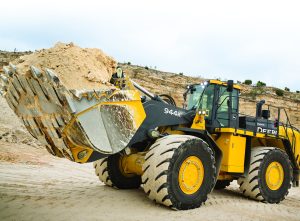
The 944K hybrid wheel loader from John Deere features a hybrid-electric drive that recaptures
energy when the operator lets off the accelerator. (Photo: John Deere)
“We’re starting to see some companies do aftermarket adjustments or installations of electrified power plants and even larger excavators, larger wheel loaders, and so the need is growing into larger equipment,” says Kleingartner.
“Low-voltage battery solutions are a good fit for compact equipment, but other technologies will be necessary as we move into higher power requirements and duty cycles,” says Gallant.
“Promising technical solutions include, but are not limited to, high-voltage battery electric machines, hybrid drives, hydrogen fuel cell and internal combustion with a variety of low- or zero-emission alternate fuels.”
WHAT’S NEXT?
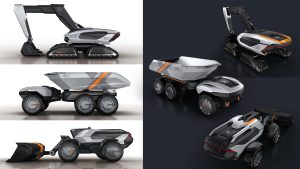
Hyundai Construction Equipment and Hyundai Doosan Infracore presented the concept of unmanned and automation construction technologies at the 2022 Consumer Electronics Show (CES) in Las Vegas. (PHOTO: Hyundai Construction Equipment and Hyundai Doosan Infracore)
As machines turn to electric power, the ability to take advantage of additional onboard technology grows as well.
“We’ve got some autonomous prototypes running,” says Kleingartner. “On the horizon are remotely operated machines… Electrical-powered machines allow you to control them more easily remotely versus having actuators control hydraulic components. The electrification of machines has definitely benefited the remote operation of machines.”
And an AI enabled jobsite may not be that far into the future, advises Stiansen. “Hearing about the autonomous work sites, where machines communicate to each other and the people that manage them, can sound like some far-off concept that’s still years down the road but it’s actually closer than you think as technological advancements continue to redefine expectations and experiences in nearly every aspect of the construction industry.”

